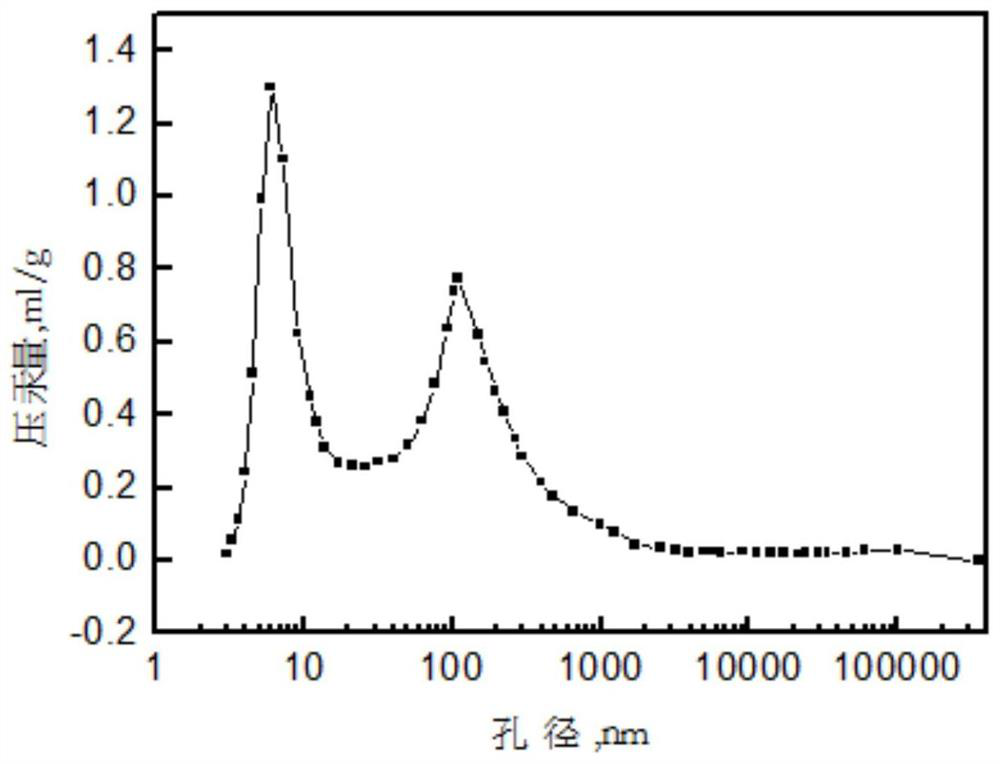A kind of desulfurization treatment method of catalytic cracking gasoline
A technology for catalytically cracked gasoline and a treatment method, applied in the field of desulfurization treatment of catalytically cracked gasoline, can solve the problems of low hydrodesulfurization activity selectivity, large loss of octane number, etc., and achieve high hydrodesulfurization activity and selectivity, octane number and the like Low alkane loss and mild operating conditions
- Summary
- Abstract
- Description
- Claims
- Application Information
AI Technical Summary
Problems solved by technology
Method used
Image
Examples
Embodiment 1
[0038] Add 25 parts (mass ratio) of styrene, 75 parts of butadiene, 200 parts of deionized water, 3.0 parts of emulsifier sorbitan ester, 1.5 parts of electrolyte KCl, 0.09 parts of chelating agent ethylenediaminetetra Sodium iron acetate (EDTA), pre-emulsified for 20 minutes, after the temperature is cooled to 5°C, add 0.04 parts of dicumyl hydroperoxide and 0.04 parts of ferrous sulfate, and 0.20 parts of regulator tertiary dodecyl mercaptan. React at 5°C for 7 hours, control the conversion rate of the two monomers at about 60%, add a mercaptan terminator, and obtain a styrene-butadiene rubber emulsion with a particle size of about 200 nm.
[0039] Weigh 250 mL of deionized water with a beaker, add 12.0 g of 68% nitric acid into the deionized water, mix well, and place in a water bath at 80°C. Weigh 9.0 g of styrene-butadiene rubber emulsion and add it into the prepared deionized water nitric acid solution, and stir evenly to obtain an acid solution containing a pore-enlargi...
Embodiment 2
[0042] Add 30 parts (mass ratio) of styrene, 70 parts of butadiene, 200 parts of deionized water, 4.0 parts of emulsifier sorbitan ester, 1.0 parts of electrolyte KCl, and 0.12 parts of chelating agent ethylenediaminetetra Sodium iron acetate (EDTA), pre-emulsified for 30 minutes, after the temperature is cooled to 5°C, add 0.04 parts of dicumyl hydroperoxide and 0.04 parts of ferrous sulfate as initiator, and 0.40 parts of regulator tert-dodecyl mercaptan. React at 5°C for 7 hours, control the conversion rate of the two monomers at about 60%, add a hydroquinone terminator, and obtain a styrene-butadiene rubber emulsion with a particle size of about 100 nm.
[0043] Weigh 260mL of deionized water with a beaker, add 15.0g of acetic acid into the deionized water, mix well, and place in a water bath at 80°C. Weigh 15.0 g of styrene-butadiene rubber emulsion and add it into the prepared deionized water acid solution, and stir evenly to obtain the acid solution containing the pore-...
Embodiment 3
[0047] Add 35 parts (mass ratio) of styrene, 65 parts of butadiene, 200 parts of deionized water, 5.0 parts of dodecanoyldiethanolamide, 0.8 parts of electrolyte KCl, 0.10 parts of pH regulator KOH in a 10L polymerization kettle. Emulsify for 20 minutes, add 0.05 parts of initiator azobisisobutyronitrile and 0.60 parts of regulator tertiary dodecyl mercaptan after the temperature is cooled to 7°C, react at 7°C for 7 hours, and control the conversion rate of the two monomers at 60% Add mercaptan terminator left and right to obtain styrene-butadiene rubber emulsion with a particle size of about 50nm.
[0048] Weigh 260mL of deionized water with a beaker, add 18.0g of acetic acid into the deionized water, mix well, and place in a water bath at 80°C. Weigh 120.0 g of styrene-butadiene rubber emulsion and add it into the prepared deionized water acid solution, and stir evenly to obtain an acid solution containing a pore-enlarging agent. Weigh 300g of pseudo-boehmite powder and 15g...
PUM
| Property | Measurement | Unit |
|---|---|---|
| pore size | aaaaa | aaaaa |
| particle diameter | aaaaa | aaaaa |
| pore size | aaaaa | aaaaa |
Abstract
Description
Claims
Application Information
 Login to View More
Login to View More - Generate Ideas
- Intellectual Property
- Life Sciences
- Materials
- Tech Scout
- Unparalleled Data Quality
- Higher Quality Content
- 60% Fewer Hallucinations
Browse by: Latest US Patents, China's latest patents, Technical Efficacy Thesaurus, Application Domain, Technology Topic, Popular Technical Reports.
© 2025 PatSnap. All rights reserved.Legal|Privacy policy|Modern Slavery Act Transparency Statement|Sitemap|About US| Contact US: help@patsnap.com



